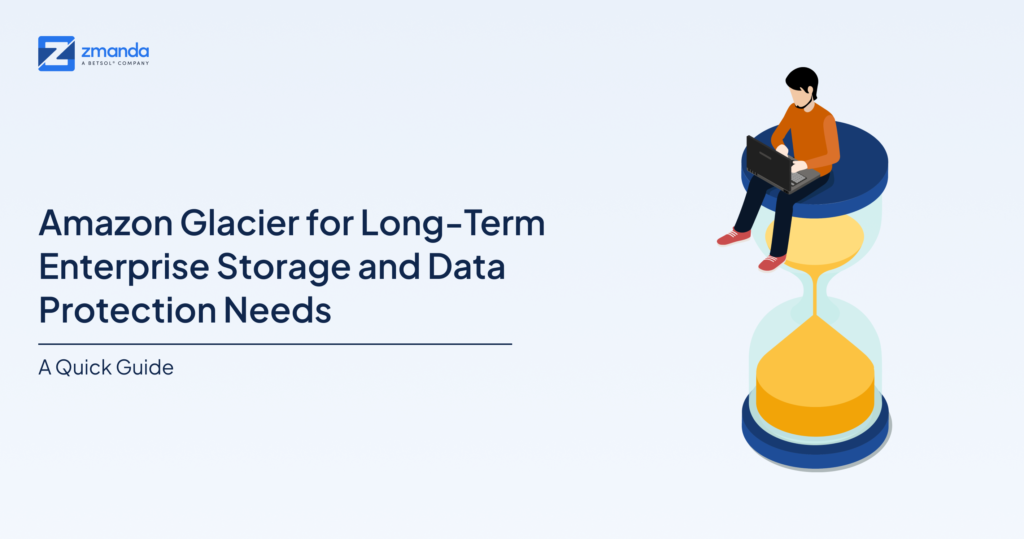
“The great growling engine of change-technology” – Alvin Toffler
Out of the many great technological revolutions we have witnessed, cloud computing deserves special mention. Many popular organizations, like Facebook, Netflix, Adobe, NASA, etc., are already using cloud computing services like Amazon Web Services (AWS) to meet their goals. This popularity is not surprising considering the flexible pricing model, availability of 60+ services, and continuous update of services offered by AWS. It is perfectly clear that AWS is more than perfect for accomplishing business objectives via the cloud. Consequently, cloud computing services are here to stay and will play a big part in organizational growth in the years to come. Now, let us examine why cloud computing flourished in the first place.
Back in the day, people set up and managed computers for their business needs. But as the business grew, the amount of data that needed to be stored and processed also increased significantly. As expected, the hardware supporting the process also needed a big upgrade with increased data processing. This multiplied the costs both in terms of the infrastructure and the staff running it. In addition, you had to invest in hardware for handling your rush hour loads even though you did not use them all the time.

Just as businesses were grappling with these challenges, cloud computing entered as the knight in shining armor. It resolved all of these challenges at a nominal cost which was a godsend at the time. Cloud computing is a setup that allows you to leverage remote servers to accomplish business processes. In simple words, cloud computing provides on-demand services via the internet.
Thanks to cloud computing, infrastructure management is off the to-do list of most businesses.
Hope all of this talk about the superpowers of cloud computing has whetted your appetite. Well then, let’s not break the momentum and jump right into one of the most popular cloud computing service providers.
Let’s see what AWS is and why should you care about it?
According to Synergy Research Group, AWS enjoys the largest market share in the global cloud infrastructure market at 34% in the second quarter of 2022. This should help you understand how the AWS offerings are perfectly in sync with the business needs of the current market. Having the right fit for your organization is important; sometimes, it can make all the difference in the intense competition out there today.
AWS is a comprehensive cloud services platform offered by Amazon. Through AWS, provisioning cloud infrastructure is quick and can be done remotely. What this means is that businesses can leverage AWS to launch arrays of workloads based on the needs of that specific day. Contrast this with an on-premises setup that demands large investments right at the beginning. You can vary your AWS resources usage depending on short- term needs to save money.
As you might already be aware, data is the currency of the future. Data plays an important role in identifying opportunities and problems in business processes. So, it is not just enough that you store data but must also run analytics on it to obtain useful insights. By backing up your data on AWS, you can leverage machine learning and AI directly on the cloud. You can get to configure account access and monitor for irregular activity using data.
With growth of profitability and productivity, it is natural for businesses to wish to expand their areas served. AWS can be a great partner in this aspect as well due their strong global presence.
AWS has set up data centers all over the world. Thanks to this distribution of cloud computing resources, you can run your applications anywhere in the world through any of the AWS Regions and Availability Zones. In AWS terms, a region is a physical location where data centers are grouped together. Again, in AWS terms an Availability Zone (AZ) is one or more data centers within an AWS Region that has redundant power and connectivity. With 27 regions and 87 availability zones, you can achieve low latency and restricting data storage to regions of your choice easily.
Now that you have an overview of what AWS is, it is now time to move on to the general advantages of using AWS for businesses.
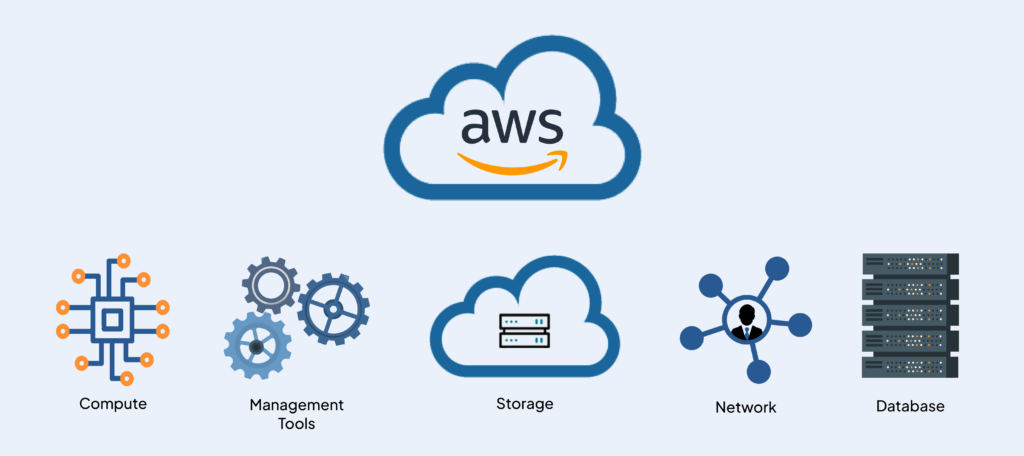
Advantages of AWS
- Business agility: You can significantly reduce your wait time for scaling up, as there are no procurements of tapes or other storage infrastructure. This translates to impressive operational flexibility for maximizing profits. This is perfect for online photo and video-sharing companies that need affordable high-volume storage. Pharma and biotechnology companies with varying workloads for computational algorithms will also find this attractive.
- Security: AWS offers reliable security mechanisms and conforms to various compliance certifications such as PCI-DSS, HIPAA/HITECH, GDPR, etc. The AWS data centers and network are specifically designed and configured to protect your valuable data. AWS data centers are secured by four distinct layers:
- Environmental layer: Concerned with eco-friendly site selection.
- Perimeter layer: Concerned with security measures like threat detectors and fences customized for specific locations.
- Infrastructure layer: Concerned with routine maintenance of networks and equipment, including data center elements like backup power equipment, fire suppression setups, and HVAC systems.
- Data layer: Concerned with the holding of customer data.
AWS also takes care of real-time security (regular monitoring by security experts), so you can focus on growing your business without any security concerns.
- Various integrated APIs: Numerous integrated APIs in diverse programming languages are available. Thanks to the integrated APIs, you can easily switch from one programming language to another. So should a situation arise wherein you need to change programming languages for any reason, you can easily do it without much fuss.
AWS Storage
AWS storage optimizes your time to market by cutting out over-provisioning and complex capacity planning. Because of it, you can access the right storage for your needs a lot faster. Software providers are already leveraging the AWS advantage to cut down their time-to-market. Popular platforms like Netflix and Instagram have transformed the way we live and work by focusing exclusively on their core offerings instead of infrastructure management.
Plus, you get a plethora of tools like high-performance computing (HPC) and big data analytics to extract more information from your data. Insights derived from these tools can take your innovation to the next level. An example would be financial market regulators leveraging big data analytics to understand the way the markets’ function.
Amazon S3
Amazon S3 is a simple storage service for objects. So, what are objects? Objects can be any kind of data like application data, images, or videos. It is just that normal data is stored as distinct units called objects in S3. The objects are further stored in containers called buckets. You can choose the AWS region where the bucket will reside during the bucket creation itself. Ideally, you should pick a region that is closest to your place of business to minimize latency and costs. While you can store any number of objects in a bucket, each object cannot be greater than 5TB.
AWS also offers the S3 Glacier storage class for data archiving. It is a low-cost storage solution. The pricing of the AWS S3 Glacier depends on the specific access pattern you opt for.
Coming to the pricing, Amazon S3 charges you for the storage used and data transfer from S3 out to the internet. The pricing will vary based on the region in which you are using the service. You can find the latest pricing information on the AWS S3 pricing page.
One of the benefits of S3 is its impressive durability of 99.999999999% (11 9s). This is achieved by replicating stored objects on S3 across numerous systems within one AWS region.
What are the some of scenarios that AWS S3 is perfect for?
- In these days of cybercrimes, you need to protect your crucial data and be prepared for any eventuality. Using AWS S3 to back up your data brings you total peace of mind. To back up to S3, you can use command line tools or AWS Storage Gateway. While command line tools allow you to back up an existing S3 bucket to another via specialized tools, the AWS Storage Gateway backs up the virtual machines from your on-premises data centers to S3 buckets.
- Amazon S3 is perfect for static website hosting that just displays information. Using S3 and CloudFront content delivery network can significantly boost your website performance. All of this comes at an affordable cost as well.
Suppose you want to run analytics on your backed-up data. In that case, S3 gives you various options, such as Amazon Redshift Spectrum, S3 Select, and Amazon Athena. You can use these analytics without moving your data anywhere. - Amazon S3 allows you to configure flexible security policies, so users can have custom permissions. This allows you to use Amazon S3 as a file-sharing solution.
Making the Most of AWS S3 With Zmanda
Did you know that according to ReportLinker, the global cloud backup market is projected to reach USD 13,135.75 million by the year 2027? It indicates the growing importance of cloud backup in these trying times.
If you are considering leveraging S3 for your cloud backup, combining it with Zmanda is a no-brainer. Cost optimization for the backup storage is one advantage where the Amazon S3 and Zmanda combo can help. You can configure auto-archiving such that data from S3 is moved to a low-cost S3 glacier.
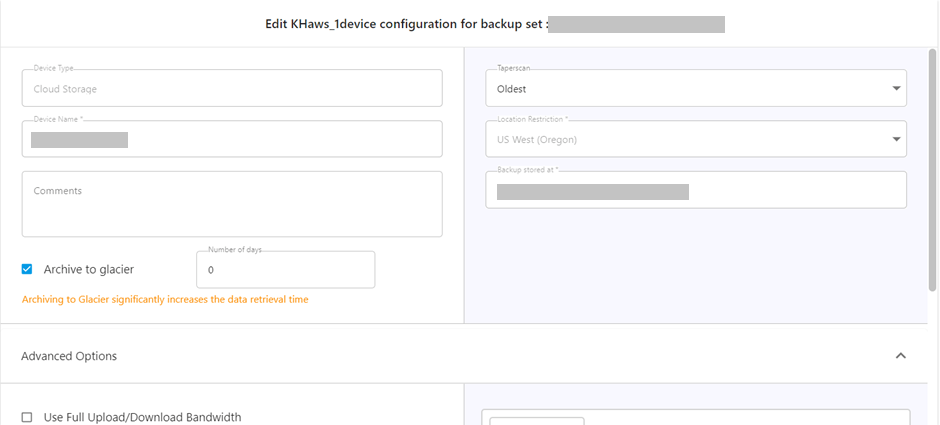
Multipart upload API
Got a big file to backup? Worried if network issues will impede the backup? Well, sit back and let Zmanda handle it for you. You can leverage the multipart upload API when you use AWS S3 as a target with Zmanda. The multipart upload API segments your large files into numerous small chunks during the upload process. The chunks are then uploaded to the AWS S3 as though they are individual objects. Once all the chunks are uploaded, a final API call is performed, which will fuse all the chunks into the final object. What’s cool is that all of this segmentation and de-segmentation is completely automated. No action is required from your end for this feature. Even if some chunk upload fails, only those missed chunks need to be uploaded again instead of the whole file.
Tweak number of threads and speed per thread
Suppose your workload hardware allows for faster backups and restores. In that case, Zmanda lets you take advantage of it via the number of threads and speed per thread specifications. Just enter the appropriate magnitude in the corresponding fields on the Backup Where page and watch your backup/restore accelerate. You can use a multipart upload for objects from 5 MB to 5 TB in size.
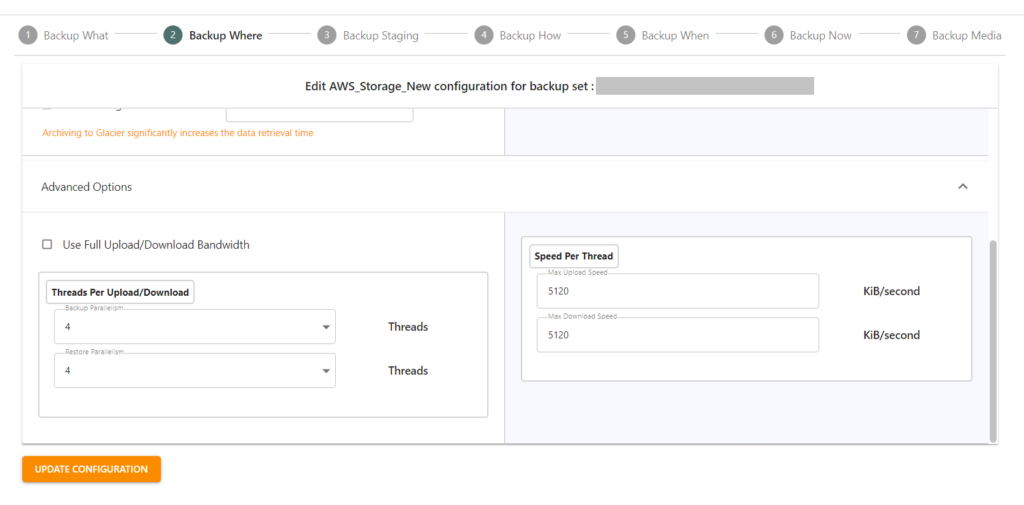
Once the initial configuration of the target as AWS S3 is done, a copy of your data is automatically sent to Amazon S3. Zmanda maintains a detailed report of these transfers for easier tracking.
With the upcoming immutable backups feature, Zmanda adds another layer of security for your cloud backups. The immutable backups feature allows you to take advantage of the S3 Object Lock feature via Zmanda. With it, you can make the backed-up data unmodifiable for a specific period of time.
As you can see, Zmanda puts your data first and supplements this goal by adding the right features at the right time.
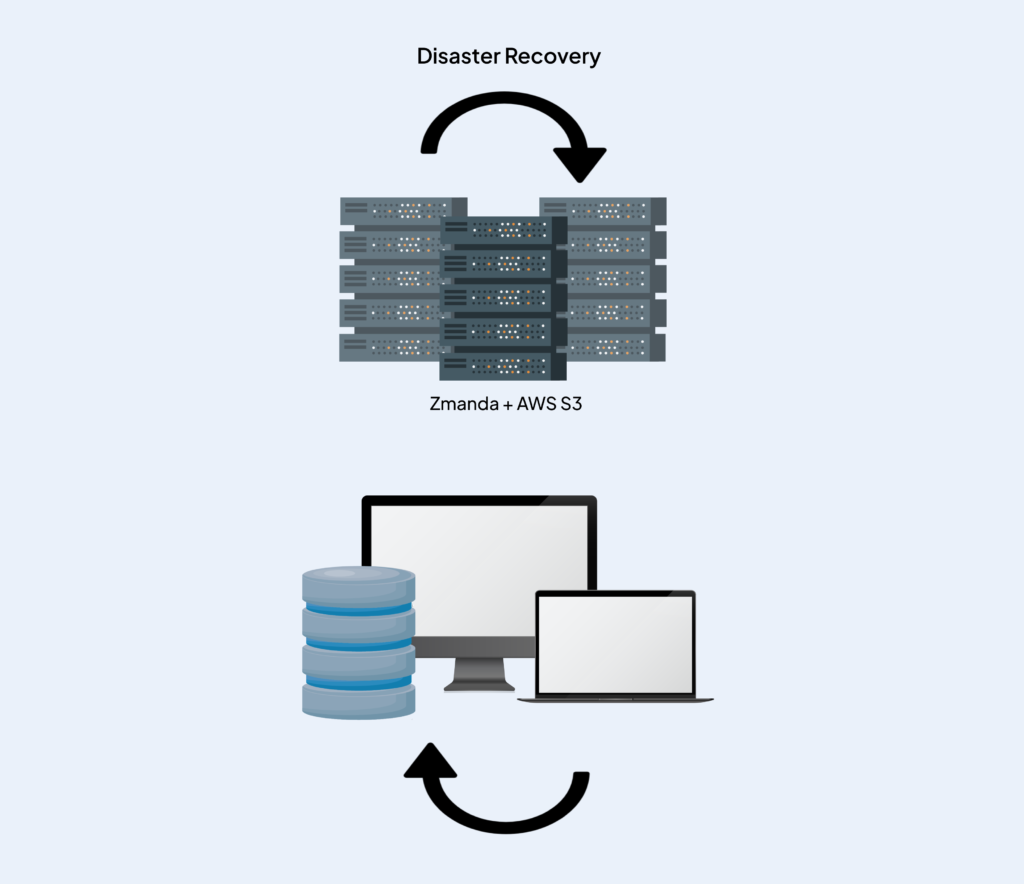
When All Is Said and Done
Zmanda’s fame for its feature richness and security needs no introduction; combine this with Amazon´s 99.9% service level agreement, and you have the dream team for disaster recovery.
The Zmanda Management console allows you to configure Amazon S3 for your backup and recovery needs easily. Moreover, staying updated could not have been simpler as Zmanda automatically sends copies of data to Amazon S3 while maintaining detailed reports.
The AWS S3 storage, together with Zmanda, is compliant with the EU Data Protection Directive. Your backup data can be restricted within the EU boundaries to ensure compliance.
If you like to vault to AWS S3, Zmanda supports that as well. Vaulting gives your data an extra layer of security.
To experience the synergy of Zmanda with Amazon S3, check out the free trial of Zmanda for 14 days. We offer you a fully licensed version so that you can explore the true potential of Zmanda. You can learn more about Zmanda by reaching out to our technical support staff or by requesting a demo.
